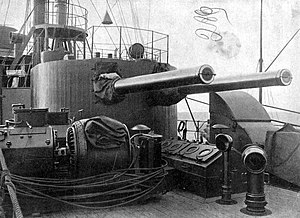152 mm 45 caliber Pattern 1892
| 152mm 45 caliber Pattern 1892 | |
|---|---|

Twin gun turret aboard the cruiser Oleg
|
|
| Type |
Naval gun Coastal artillery Railway artillery |
| Place of origin | France |
| Service history | |
| In service | 1897-1980 |
| Used by | Russian Empire Soviet Union Finland Japan |
| Wars |
Boxer Rebellion Russo-Japanese War World War I Russian Civil War Winter War World War II |
| Production history | |
| Designer | Canet |
| Designed | 1891 |
| Manufacturer | Obukhov Perm |
| Produced | 1897 |
| No. built | 351 |
| Variants | 1897-1901 1909-1918 |
| Specifications | |
| Weight | 5.8–6.3 t (6.4–6.9 short tons) |
| Length | 6.8 m (22 ft 4 in) |
| Barrel length | 5.3 m (17 ft 5 in) |
|
|
|
| Shell | Separate loading cased charge and projectile |
| Shell weight | 41.4 kg (91 lb) |
| Caliber | 152 mm (6.0 in) 45 caliber |
| Elevation | -6° to +25° |
| Rate of fire | 2-7 rpm |
| Muzzle velocity | 792 m/s (2,600 ft/s) |
| Maximum firing range | 15.5 km (9.6 mi) at +25° |
The 152mm 45 caliber Pattern 1892 was a Russian naval gun developed in the years before the Russo-Japanese War that armed a variety of warships of the Imperial Russian Navy during the Russo-Japanese War and World War I. Guns salvaged from scrapped ships found a second life on river gunboats of the Soviet Navy during the Russian Civil War and as coastal artillery and railway artillery during World War II. In 1941 It was estimated that there were 196 guns (82 in the Baltic, 70 in the Pacific, 37 in the Black sea and 7 in the Northern fleet) still in use as coastal artillery. After independence in 1917 Finland was estimated to have inherited 100 guns and some remained in use until the 1980's.
In 1891 a Russian naval delegation was shown two guns designed by the French designer Canet. One was a 120mm 45 caliber gun and the other was a 152mm 45 caliber gun. Both guns used fixed QF ammunition which produced a rate of fire of 12 rpm for the 122mm gun and 10 rpm for the 152mm gun. The Russians were impressed and in 1892 they negotiated a production license for both the 120mm and 152mm guns. In practice the rate of fire of 10 rpm was hard to achieve due to difficulties with ammunition handling. The practical rate of fire varied by class of ship from a low of 2 rpm in the Petropavlovsk-class battleships, to a high of 7 rpm in single deck mounted guns. In 1901 the fixed ammunition was changed to separate loading QF cased charge and projectile.
There were two main series of the 152mm 45 caliber Pattern 1892 guns produced. The first series of guns were constructed of a thick A tube, a 3.2 m (10 ft 6 in) long B tube and jacket. 215 of the first series of guns were built between 1897-1901, 181 at the Obhukov factory and 37 at the Perm factory. During the Russo-Japanese war a number of gun barrels burst in action and a strengthened series of 133 guns were produced, 21 at the Obhukov factory and 112 at the Perm factory between 1909-1918. The strengthened series of guns had a thinner A tube reinforced with three sections of B tube and a jacket which was 4 m (13 ft 1 in) long.
...
Wikipedia
